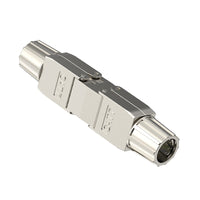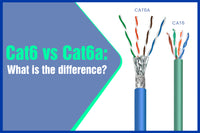Ethernet cables are commonly used to connect devices, including WiFi routers, Ethernet switches, and PCs. They play an essential role in a wired network. Ethernet cables look the same, but in fact they have differences from category to category. Different types of Ethernet cable really make a difference. Choosing the correct Ethernet cable can be challenging, and that’s why we wrote this post. This article aims to give you an Ethernet cable buying guide.
5 Things to Consider Before Buying Ethernet Cables
A proper Ethernet cable allows for a stable and better Ethernet connection. The cable performance is affected by many factors, such as type and length, and the quality and Ethernet cable price can also affect your choice. We list the following main factors for you to consider.
Ethernet Cable Types
The first and primary thing you should consider is the Ethernet cable type. The Ethernet cable types you choose will determine your maximum network speed. Knowing Ethernet cable types is very important to make you pay less and get more. You won’t get your desired rate if you use a Cat5e cable for a device that can support Cat6 speed. Using a Cat6a cable for Cat6 Internet will also be a waste. Ethernet cable types range from Cat5 to Cat8, and Cat5 cables have gradually become outdated. Look at the table below for more information about Ethernet cable performance.
| Category | Shielding Type | Maximum Speed | Maximum Bandwidth | Applications |
| CAT5 | Unshielded | 100 Mbps | 100 MHz | Suitable for old hardware but not great for new home network installation |
| CAT5E | Unshielded | 1 Gbps | 100 MHz | Home network |
| CAT6 | Unshielded/Shielded | 1 Gbps / 10 Gbps | 250 MHz | Home network or office network |
| CAT6A | Shielded | 10 Gbps | 500 MHz | Office network and data center |
| CAT7 | Shielded | 40 Gbps | 600 MHz | Data center |
| CAT8 | Shielded | 25 Gbps / 40 Gbps | 2000 MHz | Data center |
Ethernet Cable Craftsmanship
Ethernet cable craftsmanship is essential for cable quality. The conductor can directly affect the cable price and performance. Copper-clad aluminum and copper conductors are both available on the market and can be challenging to identify. Pure copper wires are often more expensive than copper-clad aluminum wires but they provide a more stable network connection. The pure copper conductor helps reduce signal loss, which helps achieve better network performance.

If you want a high-quality network, go with pure copper wires; but if you have no requirements for the network speed and want a low-cost cable, copper-clad aluminum cable may be enough for you.
Cable Jacket Rate
Generally, Ethernet cable jackets are available in flame-resistant materials and non-flame-retardant materials. As the name implies, flame-retardant cable jackets are specifically designed to prevent the spread of fire. Flame retardant cables are recommended for you for safety use.
Flame retardant cable jackets have different rates and materials. When buying network cables, you may see CM, CMP, and CMR on cable specifications. Do you know the meaning of them? In fact, CM, CMP, and CMR are Ethernet cable ratings.
CM cables (communications multipurpose cables) are the basic rating for general use. CM cables are often known as patch cables, which can offer great flexibility when connected to your computer in short runs. CMR cables (Communications Multipurpose Cable, Riser) are higher rated than CM cables and are often used to spread fire from the floor to another place. CMP is a plenum-rated cable that is usually installed in air plenum spaces.
There are also different types of cable jacket materials, such as PVC and LSZH. PVC (Polyvinyl Chloride) is a common material used in Ethernet cable, but it can cause hazardous gas when burned. The full name of LSZH is Low Smoke Zero Halogen, which is inferior to PVC as it won’t emit toxic gas when burned. In Europe, LSZH cables are more prevalent for their added safety.
Ethernet Cable Connectors
Ethernet cable connectors, also known as RJ45 connectors, are installed on two ends of the Ethernet cable. You know that silver has better conductivity than copper and gold, but it is easy to oxidize. Thus, Ethernet cable connectors are often gold-plated for a stable and long-lasting Internet connection. The thickness of gold plating is also an essential factor for RJ45 connector performance. For a more stable and reliable network connection, 50-micron gold plating is recommended for you.
As is known to all, copper is a good conductor, but the humid environment can affect the copper performance and network signal. To avoid the risk of corrosion, you should choose the gold-plated Ethernet cable connector.

Ethernet cable connectors come in different types and styles. If you don’t want to buy pre-terminated cables and wanna DIY your network, you can choose RJ45 connectors based on your needs.
Cable Color

What are the meanings of different cable colors? In fact, it depends on different manufacturers. But there are also some widely accepted cable colors such as black, grey, green, and yellow.
Grey Ethernet cables are the standard cables for network connection and are often seen in family and office network installations.
Black is a general color, and black Ethernet cables are used for outdoor applications to withstand exterior elements.
Power over Ethernet (PoE) connection often uses yellow Ethernet cables for easy identification.
Red cables are generally designed for phone systems. And Green Ethernet cables are used in the termination of a network connection.
For more information on this topic, you can keep up on our blogs. While VCELINK offers general and basic information for our customers and other visitors to the website, it’s not professional advice.




Be the first one to comment.
Leave a comment